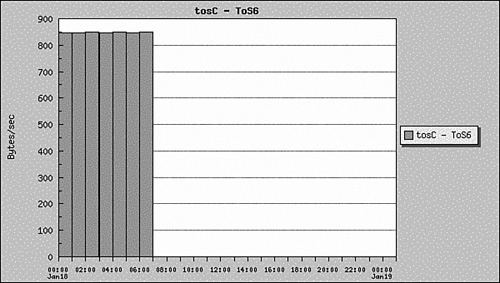DSMON MIB
Differentiated Services (DiffServ) monitoring, also called DSMON, is designed to monitor the network traffic usage of Differentiated Services Code Point (DSCP) values (0 to 63) as defined by RFC 2474. The DSMON MIB (Remote Monitoring MIB Extensions for Differentiated Services, specified by RFC 3287) extends the RMON mechanisms to support additional packet classification, based on DSCP values observed in monitored packets. By polling DSCP counters, a network management application can determine performance details, such as network throughput for traffic associated with different DSCPs.
The DSMON MIB is intended to be implemented in RMON probes that support the RMON-2 MIB (RFC 2021). The DSMON functions should be implemented in conjunction with the associated RMON functions, but the MIB is independent of all other RMON data tables. Several concepts and even MIB objects from the RMON MIBs are used in the DSMON MIB. The RMON-2 MIB defines the protocolDirTable, which is a directory of all the protocols that the RMON-2 agent can decode and count. The DSMON MIB uses this directory to identify the protocols detected in monitored packets. The protocolDirLocalIndex MIB object is used to identify protocol encapsulations in all DSMON data tables, which classify and aggregate by protocol type in some manner. The DSMON MIB uses the "SNMPv1 coexistence" strategy adopted by the RMON working group. That is, where a 64-bit counter is provided, a 32-bit version of the counter and a 32-bit overflow counter are also provided. The DSMON MIB uses the same Top-N reporting MIB structure as the RMON-2 MIB. Top-N reporting can greatly reduce the polling overhead required to analyze DSCP usage patterns.
The DSMON MIB uses the following statistics:
Full Duplex Interface Statistics
Protocol Statistics
Protocol Top-N Statistics
Network Host Statistics
Network Host Top-N Distribution
Application Matrix Statistics
Application Matrix Top-N Distribution
DSMON MIB Principles
The principles of the DSMON MIB are as follows:
It extends RMON functionality to support Differentiated Services monitoring.
It provides aggregated functions based on DSCP values.
The MIB contains 32-bit and 64-bit SNMP counters.
Supported Devices and IOS Versions
Cisco routers and switches do not support the DSMON MIB. The Cisco NAM for the Catalyst 6500 series and the Branch Router Series NAM fully support it.
CLI Operations
Cisco routers and switches do not support DSMON. For configuration details on the Cisco NAM, refer to the online documentation at http://www.cisco.com/go/nam.
SNMP Operations
The DSMON MIB contains six groups of MIB objects:
dsmonAggregateControl group controls the configuration of counter aggregation groups for the purpose of reducing the total number of counters maintained by the agent.
dsmonStatsObjects group reports a distribution statistics per counter aggregation group for a particular RMON dataSource.
dsmonPdistObjects group reports per-counter aggregation group distribution statistics for each application protocol detected on a particular RMON dataSource.
dsmonHostObjects group reports host address distribution statistics for each counter aggregation group detected on a particular RMON dataSource.
dsmonCapsObjects group reports the static DSMON MIB functional capabilities of the agent implementation.
dsmonMatrixObjects group exports host address pair distribution statistics for each counter aggregation group detected on a particular RMON dataSource.
Examples
Cisco routers and switches do not support DSMON. For configuration details on the Cisco NAM, refer to the online documentation at http://www.cisco.com/go/nam.
Figure 5-4 shows the result of a DSCP monitoring run by the NAM. The various DSCP values are measured by traffic rate over time.
Figure 5-4. NAM DSCP Monitoring Example








